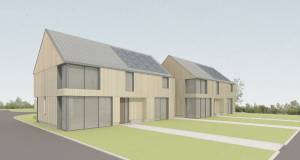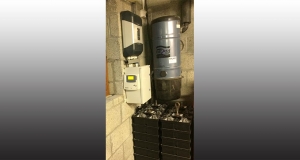- Opinion
- Posted
Minimising Development Risk

In an increasingly risky property market Richard Douthwaite looks at what developers can do to protect their investment.
It must be a nervous time for developers. On the one hand, house prices are rising rapidly. They rose in April at a faster rate than at any time in the past six years. On the other hand, the OECD reckons that there's a 50:50 chance that the Irish housing market will suddenly slow. So, if the market continues along its present merry way, developers stand to make very good profits while, if it falters, they must expect a hefty loss. It's rather like a game of pass-the-parcel. They don't want to be holding property when the music stops.
Nationally, house prices have almost doubled in the past five years, moving from an average of €175,000 in the first quarter of 2000 to just under €350,000 in the final quarter of last year. Dublin prices have also doubled, to reach an average of €450,000 at the end of last year. A further rise of about 10% is expected this year, adding €35,000, or more than a year's average industrial wage (€30,000), to prices in the country and €45,000 in Dublin. This means that a house could cost 12 times average industrial earnings in the country and almost 16 times in the capital.
Historically, this figure is very high indeed, as the affordability figures in Graph 2 show. Affordability is taken as the annual cost of servicing a new twenty-five year mortgage relative to average income. This figure has averaged 28% over the past thirty years, with a high of 39% in the early 1980s (when mortgage rates were around 15%) and a low of 20% in 1994. Since then the figure has moved up steadily to an estimated 31.5% in 2005 and is expected to reach 35% nationally this year. It is already more than that in Dublin. According to Goodbody Stockbrokers, a typical two-income Dublin household needed to spend 35.5% of its disposable income in 2005 to service the first year of its 25-year mortgage. In 1995, it would have had to spend only 21.2%.
This creates real problems for people trying to raise a 10% deposit for a house. For the country as a whole, the deposit amounted to 38% of household disposable income in 1994-1995, but this ratio reached 63% in 2005.
Another way of measuring housing affordability is to compare the median house price with the median income. Over several decades and in many countries, the median house has cost roughly three times the median income. Now, in Britain, Ireland and several other markets, house prices have risen sharply in relation to the median income with the result that Demographia, an organisation which tracks house prices using this measure, rates Dublin house prices as 'severely unaffordable'. “The present extent of housing unaffordability is unprecedented, both historically and across markets” it states. “Most housing markets have exhibited median multiples of near 3.0 or less in the past and many still do.”
The banks have pretended to help buyers cope with the twin problems of affordability and getting the deposit together. They have abolished deposits by giving 100% mortgages and extended the mortgage period out to as long as 40 years. The availability of these mortgages, of course, does not help the situation at all. It merely means that everyone has to borrow more, and for longer, to be able to compete on equal terms in the housing market. A recent survey by Bank of Ireland showed that 50% of first-time buyers took the option of a 35-year mortgage term in 2005, as opposed to 25% in 2004 and only 4% in 2000. Moreover, the change won't suit the banks themselves if the economy dips and house prices halve, dropping back to their long run median multiple of 3. Thousands of unemployed people with debts greater than their property's value will want to clear up the situation by handing over the keys.
Forty-year mortgages are a warning that things are getting out of hand. In Japan, just before the property market crashed in 1991, buyers could get 100 year or multi-generational mortgages. Prices there have dropped over 35 per cent from their peak and are still falling. Yet the rise in Japanese house prices in the seven years to 1991 was only 36%, considerably less than the rise in the past seven years in Ireland.
Many Japanese banks became insolvent and only survived because the central bank allowed them to pretend they weren't. Irish banks will only have themselves to blame if they find themselves in the same predicament. As David Buckeridge of the Mortgage Company of Ireland points out, as recently as 2002, the banks limited buyers to borrowing 2.5 times the primary income plus once times the secondary one. Now, five times the joint income is common.
Buckeridge thinks that the arrival of 160,000 Eastern Europeans is underpinning the market at present. However, if the music stops, the economy will falter and many of them will go home. The underpinning will be gone, particularly in the rented sector.

Developers are therefore facing a real risk that the market will suddenly buckle under them, just as it did in Britain in 1989 when conditions changed in just two weeks. What can they do to minimize the price cuts they will have to make to unload whatever they are building at the time?
If the economy moves into a recession, people will become much more concerned about the total cost of house ownership than they are at present. With less money about, it will not be just the cost of paying the mortgage that will worry them, but the cost of heating the house and of getting to and from it to their work. Transport took 16.4% of the average household budget in 2000, the most recent year for available CSO figures. This is a very significant amount, particularly when one considers that food takes about 20% of a family budget and fuel and light about 10%. It is therefore a prime target for cuts, particularly when you consider that spending on it increased by 67% in only five years. People may find it easier to revert to their earlier habits by, say, getting rid of the second car, than cutting their spending in other ways.
A transport economist, Brian Guckian, recently calculated that someone who had to run a car to travel every working day from Navan to Dublin incurred a cost of about €12,000 a year. So the smart developer will concentrate on building houses in good locations where a one-car or no-car lifestyle is an attractive proposition rather than a hardship. Many one-off houses in the country will become unsaleable if there is no economic reason for them to be where they are. So will houses on the estates that have recently sprung up in villages all around Irish cities. These remind me of the houses in the mining villages in which I grew up except that there's no colliery to support them. They depend on a daily commute, which makes them a high cost, and therefore unattractive, place to live.
But many developers already own badly-located sites – what should they do? The best answer is probably “Bail out quickly – sell them on to someone else.” Failing that, they should cut the total cost of living in the properties they are building in every way they can. Reducing heating costs by installing heat recovery ventilation, lots of insulation and so on, for example, is one way. The economics work out well. A typical house of 100 square metres built to the current regulations will require around 125 kWh/square metre for heating and hot water during a year. That is, if it actually meets the current standard. Surveys have shown that sloppy workmanship means that very few new houses do.
Anyway, assume the house does achieve that figure and has a floor area of 150 square metres. If it is heated by oil, and the boiler is reasonably efficient, that house will take around 1,690 litres of oil a year. At a price of 60 cents a litre, that gives an annual heating cost of €1,014, around the amount of the monthly mortgage payment. If, on the other hand, the house was built to SEI's House of Tomorrow standard, 75 kWh/sq. metre, this cost would fall to about €600 a year. And if the developer gets down to 50kWh/sq. metre, as many people are trying to do, the cost would be down to €400. This €600/year saving ought to put around €12,000 on the value of the house at current oil prices and much more in future since there's no reason to suspect that oil prices will stay where they are for very long. As a result of resource depletion, world oil production can no longer keep up with world demand.
Oil is much the best fuel for transport and we can't expect significant substitutes for it in this use to come along soon. As a result, as global supplies shrink over the next 25 years, its price could go very high indeed, because people and goods just have to move around. There's a second reason for anticipating much higher oil prices, too. The amount of energy in ten litres of diesel oil or the kerosene you might use in your furnace is equivalent to the amount of energy a manual labourer can deliver in a year. So, if you are a contractor, how much will you be prepared to pay for ten litres of oil for your Hymac before you decide to hire a gang of men with picks and shovels instead?
What this means is that the cost of the energy required for transport and heating will become an increasingly important component of the cost of owning a house, and will have a massive bearing on the price it fetches on the market. Buyers will not be content with its official energy rating, as this is theoretical, being based on the house's design rather than its actual performance. Instead, just as people get a surveyor to check the structural integrity of a property they intend to buy, it will probably become quite routine in future for them to have an actual energy-demand survey carried out. This might involve heating the house to a specified amount above the outside temperature and using a thermal-imaging camera and blower door test to determine how much heat is escaping through the walls and roof and where any particular cold-spots are. The cost of such a survey could be covered many times by the reductions the seller is forced to make.
Pricked by the recent series in rises in the interest rate, the property bubble is already deflating in the US in places which Demographia rated as “severely unaffordable”. No one can be sure whether the same thing will happen here but, as EU interest rates are rising too, it's commonsense for developers to restrict themselves to building well-located, energy-efficient properties that will have a better chance of selling in the tough market that would result if the music stopped.
Related items
-
 The world energy crisis 2022
The world energy crisis 2022 -
 Grant heat pumps at centre of NI energy transition project
Grant heat pumps at centre of NI energy transition project -
 SEAI Energy Awards 2020 open for entries
SEAI Energy Awards 2020 open for entries -
 New Leeds developer goes passive
New Leeds developer goes passive -
 The Jodrell Bank grand challenge
The Jodrell Bank grand challenge -
 Reaching for the first rung
Reaching for the first rung -
 New property finance platform offers chance to invest in Dublin passive house
New property finance platform offers chance to invest in Dublin passive house -
 Why housing isn't viable
Why housing isn't viable -
 Use all your solar electricity at home rather than export it — Warik Energy
Use all your solar electricity at home rather than export it — Warik Energy -
 SEAI Energy Show to take place on 6 & 7 April
SEAI Energy Show to take place on 6 & 7 April -
 Passive House Plus editor explains passive house to RTE's Eco Eye
Passive House Plus editor explains passive house to RTE's Eco Eye -
 Could the death of zero carbon help passive house bloom?
Could the death of zero carbon help passive house bloom?





